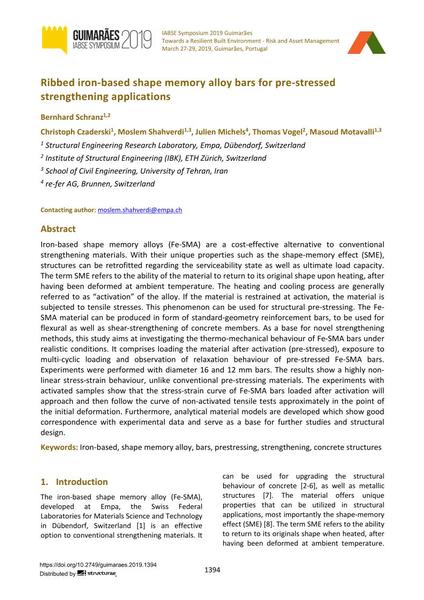Ribbed iron-based shape memory alloy bars for pre-stressed strengthening applications

|
|
|||||||||||
Bibliographic Details
| Author(s): |
Bernhard Schranz
(Structural Engineering Research Laboratory, Empa, Dübendorf, Switzerland; Institute of Structural Engineering (IBK), ETH Zürich, Switzerland)
Christoph Czaderski (Structural Engineering Research Laboratory, Empa, Dübendorf, Switzerland) Moslem Shahverdi (Structural Engineering Research Laboratory, Empa, Dübendorf, Switzerland; 3 School of Civil Engineering, University of Tehran, Iran) Julien Michels (re-fer AG, Brunnen, Switzerland) Thomas Vogel (Institute of Structural Engineering (IBK), ETH Zürich, Switzerland) Masoud Motavalli (Structural Engineering Research Laboratory, Empa, Dübendorf, Switzerland; 3 School of Civil Engineering, University of Tehran, Iran) |
||||
|---|---|---|---|---|---|
| Medium: | conference paper | ||||
| Language(s): | English | ||||
| Conference: | IABSE Symposium: Towards a Resilient Built Environment Risk and Asset Management, Guimarães, Portugal, 27-29 March 2019 | ||||
| Published in: | IABSE Symposium Guimarães 2019 | ||||
|
|||||
| Page(s): | 1394-1401 | ||||
| Total no. of pages: | 8 | ||||
| DOI: | 10.2749/guimaraes.2019.1394 | ||||
| Abstract: |
Iron-based shape memory alloys (Fe-SMA) are a cost-effective alternative to conventional strengthening materials. With their unique properties such as the shape-memory effect (SME), structures can be retrofitted regarding the serviceability state as well as ultimate load capacity. The term SME refers to the ability of the material to return to its original shape upon heating, after having been deformed at ambient temperature. The heating and cooling process are generally referred to as “activation” of the alloy. If the material is restrained at activation, the material is subjected to tensile stresses. This phenomenon can be used for structural pre-stressing. The Fe- SMA material can be produced in form of standard-geometry reinforcement bars, to be used for flexural as well as shear-strengthening of concrete members. As a base for novel strengthening methods, this study aims at investigating the thermo-mechanical behaviour of Fe-SMA bars under realistic conditions. It comprises loading the material after activation (pre-stressed), exposure to multi-cyclic loading and observation of relaxation behaviour of pre-stressed Fe-SMA bars. Experiments were performed with diameter 16 and 12 mm bars. The results show a highly non- linear stress-strain behaviour, unlike conventional pre-stressing materials. The experiments with activated samples show that the stress-strain curve of Fe-SMA bars loaded after activation will approach and then follow the curve of non-activated tensile tests approximately in the point of the initial deformation. Furthermore, analytical material models are developed which show good correspondence with experimental data and serve as a base for further studies and structural design. |
||||
| Keywords: |
strengthening prestressing shape memory alloy Concrete Structures Iron-based bars
|
||||
